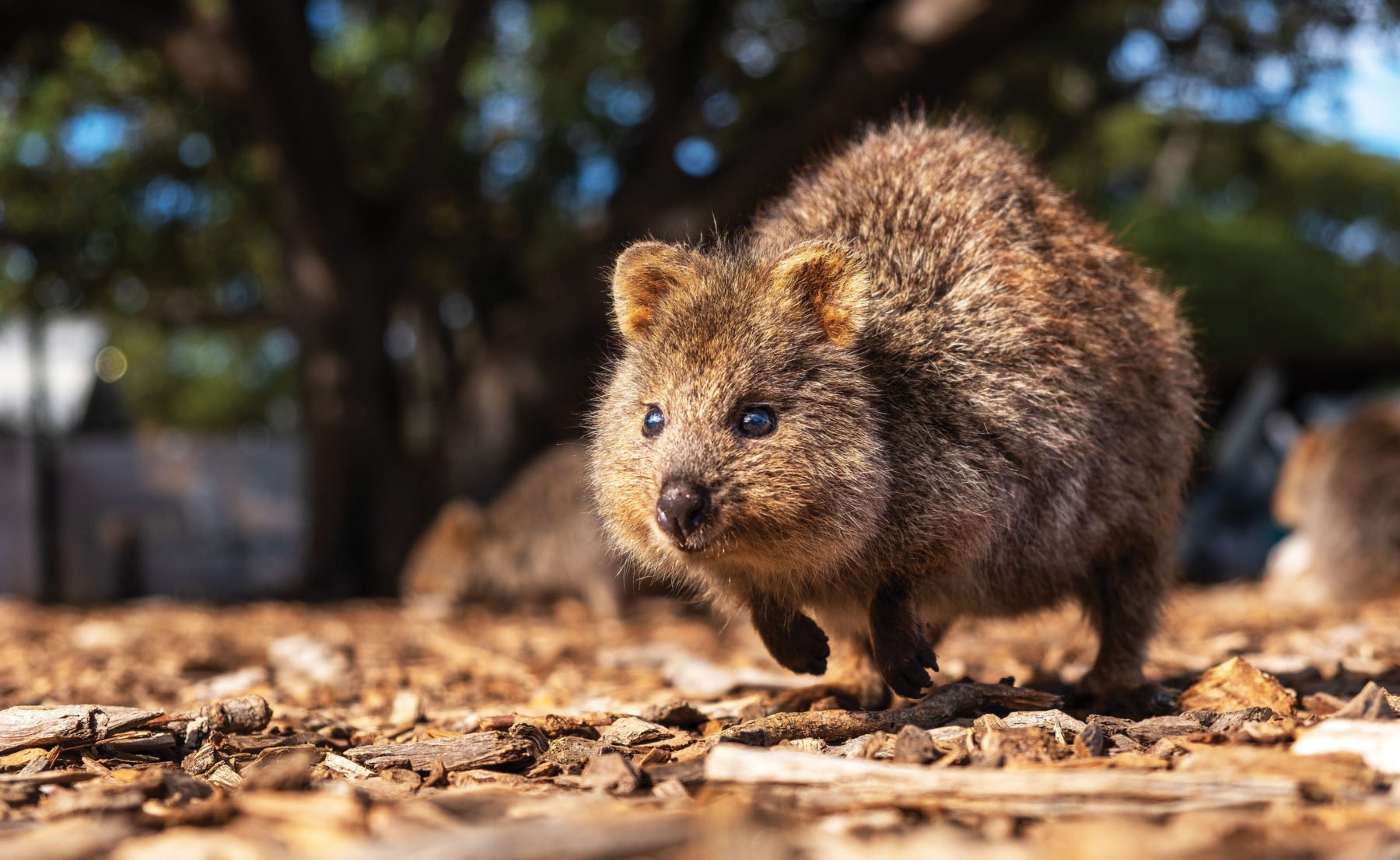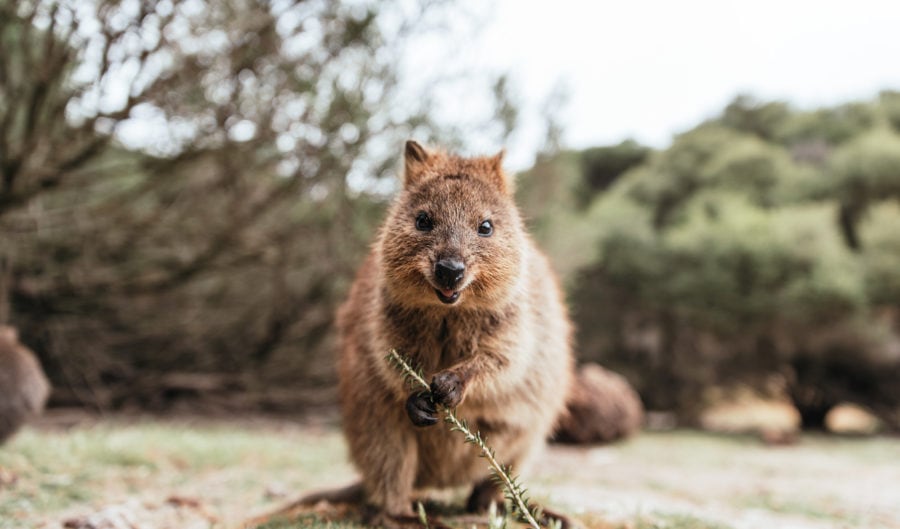Scroll through the Instagram account of tennis great Roger Federer and among his snippets on great matches and life on the pro circuit you’ll find a photo of him taken in 2017 on Western Australia’s Rottnest Island with a quokka (Setonix brachyurus).
Since that image went viral, a slew of celebrities – including actor Chris Hemsworth, singer Kylie Minogue and surfing legend Kelly Slater – have snapped their faces with the tiny, seemingly smiling, wallabies. So too have thousands of less-famous quokka enthusiasts. At least 66,000 quokka selfies now reside on Instagram. In 2019, before COVID hit travel worldwide, the island experienced an increased visitation rate of 15 per cent on the previous year, a rise the Rottnest Island Authority (RIA) attributed partly to the quokka selfie craze.
Quokkas don’t, of course, smile. They just look like they do. And if you search for #quokkaselfie on the social media platform where the craze began, you’ll now receive this warning: “You are searching for a hashtag that may be associated with posts that encourage harmful behaviour to animals or the environment.”
It seems, however, that there are bigger concerns for quokkas than overenthusiastic tourists.
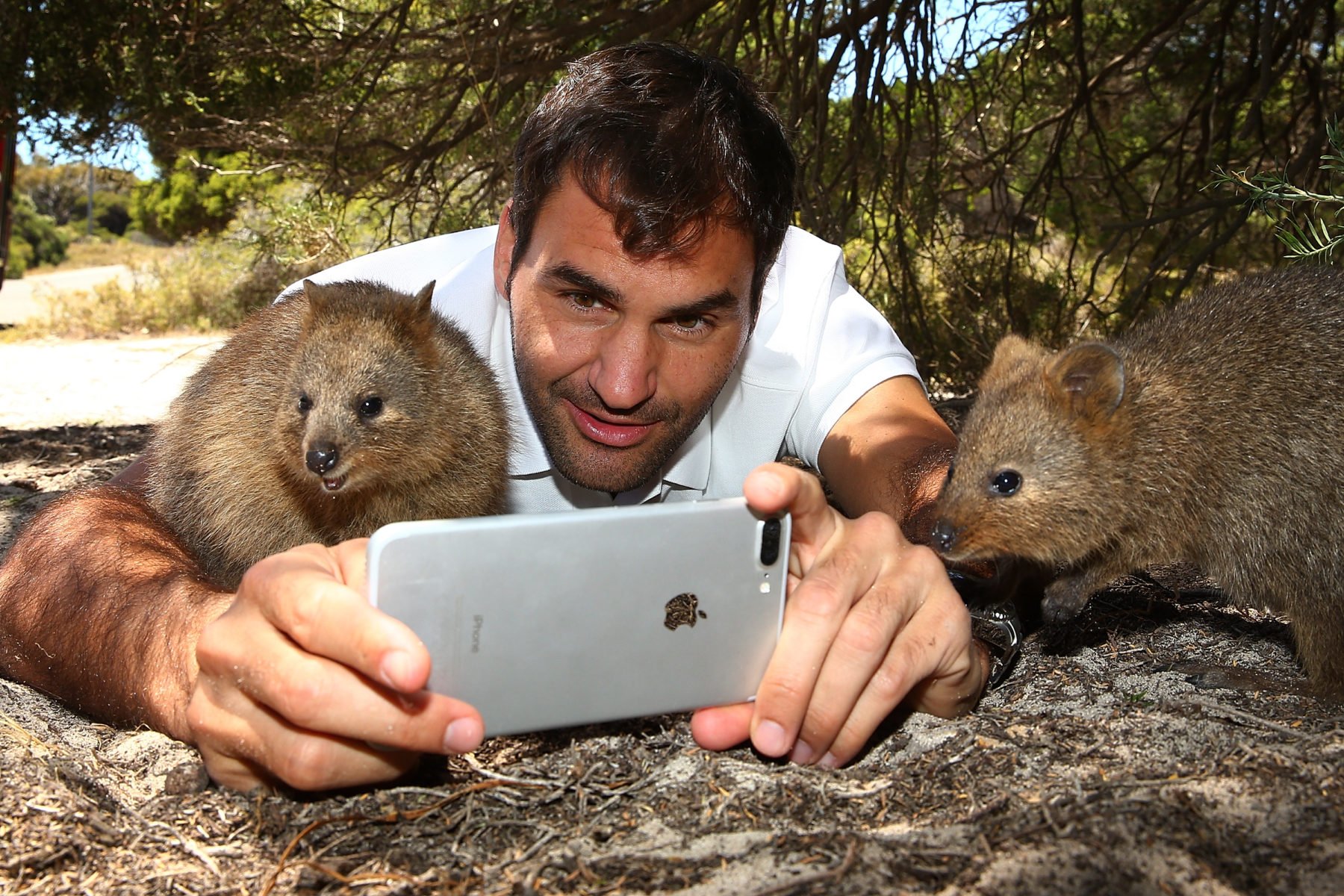
The problem with the quokka selfie
It’s estimated there are 10,000–12,000 quokkas on Rottnest Island, which is 30 minutes by ferry from Fremantle. And with the island free of the voracious introduced predators – mostly foxes and feral cats – that their mainland counterparts contend with, they appear to live contented lives.
Plenty of signs clearly warn visitors to Rottnest not to touch or feed the quokkas. When I visited recently, I began encountering the cute furballs just a short walk from the ferry terminal in the main settlement of Thomson Bay. At the Rottnest Bakery gates have been installed to prevent quokkas entering the deck area. But the wily marsupials find a way, and scavenge for food scraps under, and sometimes on, picnic tables.
I wander the settlement and see several selfies in progress – visitors lying on the path or sitting in the dirt next to bemused quokkas that appear to be checking if a hand-out is coming. I’m snapping away too but I’m not taking selfies. A wet winter and the plentiful grass that’s followed seem to have fuelled a baby boom, and plenty of adorable joeys are periodically poking sleepy heads out of pouches to investigate the world.
Despite its tourist pull, Rottnest’s environment officers, Jessica (Jess) McNamara and Evan Hallein, aren’t fans of the quokka selfie. “We prefer that people just observe them and don’t try to interact with them,” Jess says. “The more human interaction they’re exposed to, the more distant they’re going to be from their normal behaviour. If they’re used to having a pie or being fed by humans, then they’re not going to be able to fend for themselves, and human food can be toxic.”
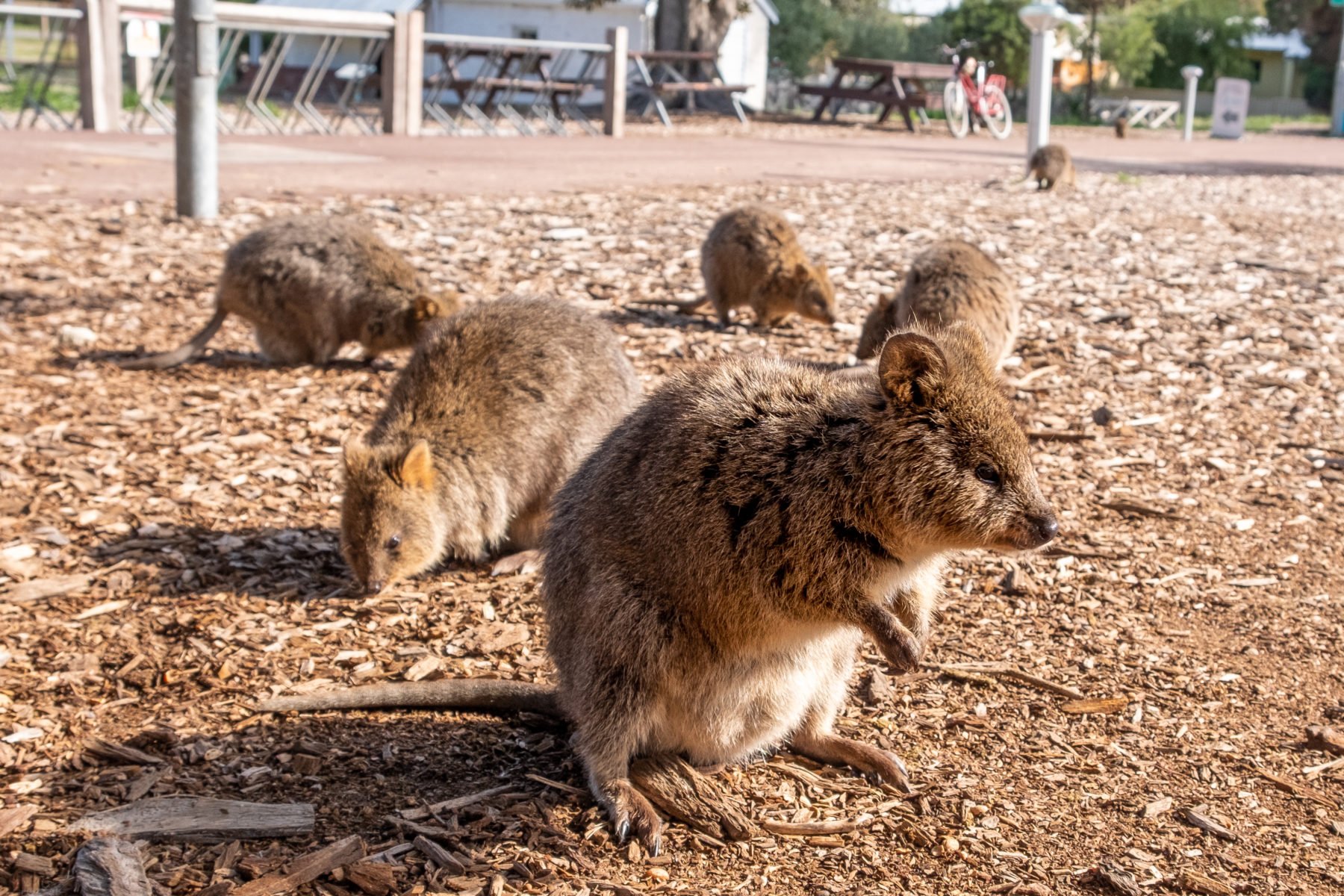
Jess and Evan urge people to value the marsupial’s authentic behaviours instead of their social media model potential. They’d prefer to see all visitors venture beyond Thomson Bay to see quokkas that have not become habituated to humans.
“Let’s try and respect them and let them be what they are, which is wild animals,” Jess says. “If you want to get on a bike, you might go and find the ‘wild’ quokkas. It’s really worthwhile when you actually see one in the reserve itself. It’s lovely because they are a bit evasive. If I was to advocate for anything it would be go and see them – see them in their wild habitat. See how our influence is changing that.”
Jess and Evan are responsible for, among other duties, monitoring Rottnest’s quokka population. For the past three years they’ve been using soft, cage-like devices called Thomas Traps baited with apple to physically capture the marsupials so they can check on their condition. So far, all monitoring indicates the health of the island’s quokka population is excellent.
But RIA staff would like to be able to deploy a less invasive approach. The possibility of observing the marsupials using camera traps is being explored, with a view to establishing 40 monitoring points across the island. It’s hoped these could be used to observe quokkas exhibiting more natural behaviours, not influenced by physical traps.
Another duty of Jess and Evan is revegetation, but counterintuitively this will ultimately result in a reduction in quokka densities. Jess says that when Europeans first settled on Rottnest, they cleared most of the woodland, and it now covers only about 4 per cent of its original area. The cleared sites have become dominated by coastal heath. Now native trees, such as the Rottnest Island pine and coastal mock orange, are being re-established. With the shift away from grass and other easy food, it’s expected quokka numbers will stabilise at a lower, more natural, number.
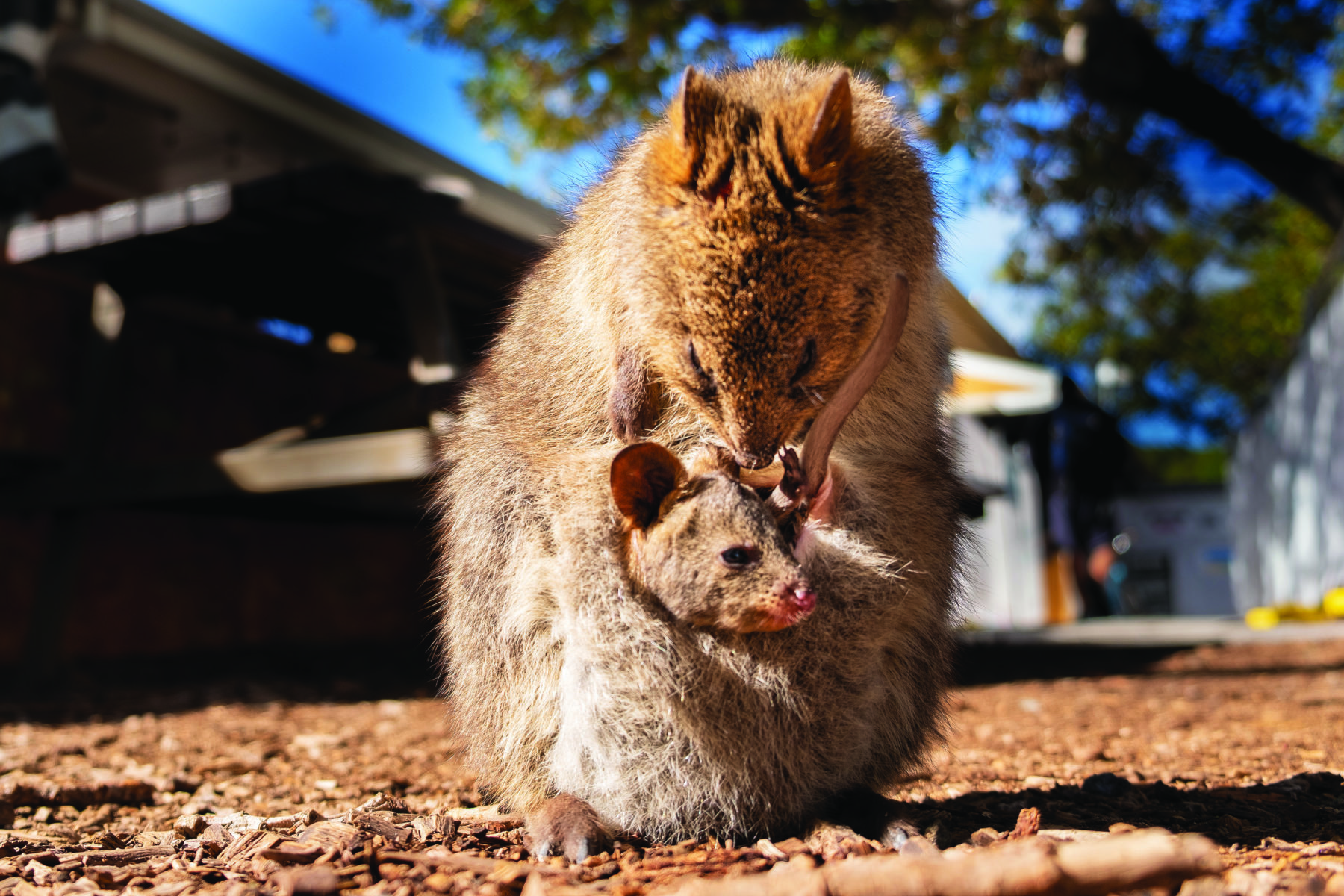
The mainland quokkas
It seems strange that the conservation status of the quokka is listed as vulnerable, given how many of the species I’ve seen here. But the fossil record indicates that before European settlement happened quokkas occurred across perhaps 49,000 sq.km of the forested South West region of WA. Today, there are very few quokkas remaining on the mainland. In fact, they are so rare and elusive that many West Australians are unaware that they’re there at all.
These mainland quokkas are of vital importance because their genetic diversity could hold the key for the survival of the species. A major threat to island populations, or any geographically isolated populations, is reduced genetic diversity due to inbreeding. The potential for this has been studied in the Rottnest quokkas but, Evan explains, so far there is no cause for concern. “While there’s a lower – about 70 per cent – diversity [among Rottnest animals] compared with mainland quokkas, there’s no evidence of inbreeding,” he says.
On the mainland, however, the quokka’s survival as a species is tenuous. The largest connected group of individuals – a metapopulation – is found in the WA Southern Forests, which stretch from south of Bunbury through to the south coast town of Denmark. This area is thought to support about 3000 quokkas. The tiny town of Northcliffe is in the middle of this distribution, making it strategically important for quokkas and their habitat connectivity.
The Northcliffe quokkas have been relatively well studied by the WA Department of Biodiversity, Conservation and Attractions (DBCA), and it’s known that up to 594 quokkas previously made up this Northcliffe sub-population. However, disaster struck in 2015 when a catastrophic fire destroyed 98,000ha of vital habitat.
A joint project between WWF-Australia and DBCA to research the impact of the event on the Northcliffe quokkas found that one year after the bushfire only 39 quokkas could be found. Five years later, at the end of last year, numbers had built to 272 – about 40 per cent of the original sub-population. A full recovery to pre-fire levels is expected, but not until 2028, and only if no further catastrophes occur.
Dr Rochelle Steven, WWF-Australia’s conservation project coordinator for the South West region, says that although this sub-population was drastically reduced, its connectivity to other populations remains critical.
“For any population that has a limited geographic extent, or if there’s a barrier to them being able to flee an area during a random catastrophic event – it’s not going to end well for that sub-population,” Rochelle says.
Just as isolation is a potential problem on Rottnest Island, it can also be a problem on the mainland once habitat becomes fragmented due to fire or other land clearing. When an animal can move freely around the landscape – by having, for example, adequate corridors to be able to reach others during breeding season – there’s an increased chance of genetic diversity, Rochelle explains.
“That’s why habitat fragmentation on the Australian continent is so much of a problem. We’re essentially cutting off many sub-populations of many threatened species – and perhaps those yet to become threatened – resulting in a loss of genetic diversity,” she says.
The WWF–DBCA study found quokkas need adequate shelter, presumably for safety, to travel for breeding or foraging. One factor dictating how far quokkas will venture is the tree canopy, which may seem strange for an animal that usually lives close to the ground.
On average, quokkas were found only 12.5m from intact canopy. Recolonising rates post-fire were dictated by availability of canopy cover. Areas with no remaining canopy had low occupation rates more than four and a half years after the fires had gone through.
“The importance of canopy was a bit of a surprise,” Rochelle says. “But it makes sense. That lower vegetation structure they prefer may need to develop under certain microclimatic conditions. If you’ve removed the upper canopy, you’ve exposed the under canopy and it tends to dry out more. The understorey doesn’t get the chance to become dense and thick the way quokkas need.”
The ecology consultant conducting the study, Dr Karlene Bain, says that here many sub-populations are still able to integrate with each other, providing good gene flow. Further north, in the Northern Jarrah Forest, quokkas are not so connected. “A series of sub-populations are now completely isolated from each other between Collie and Perth,” Karlene says. “These are already extremely genetically compromised due to the lack of gene flow.”
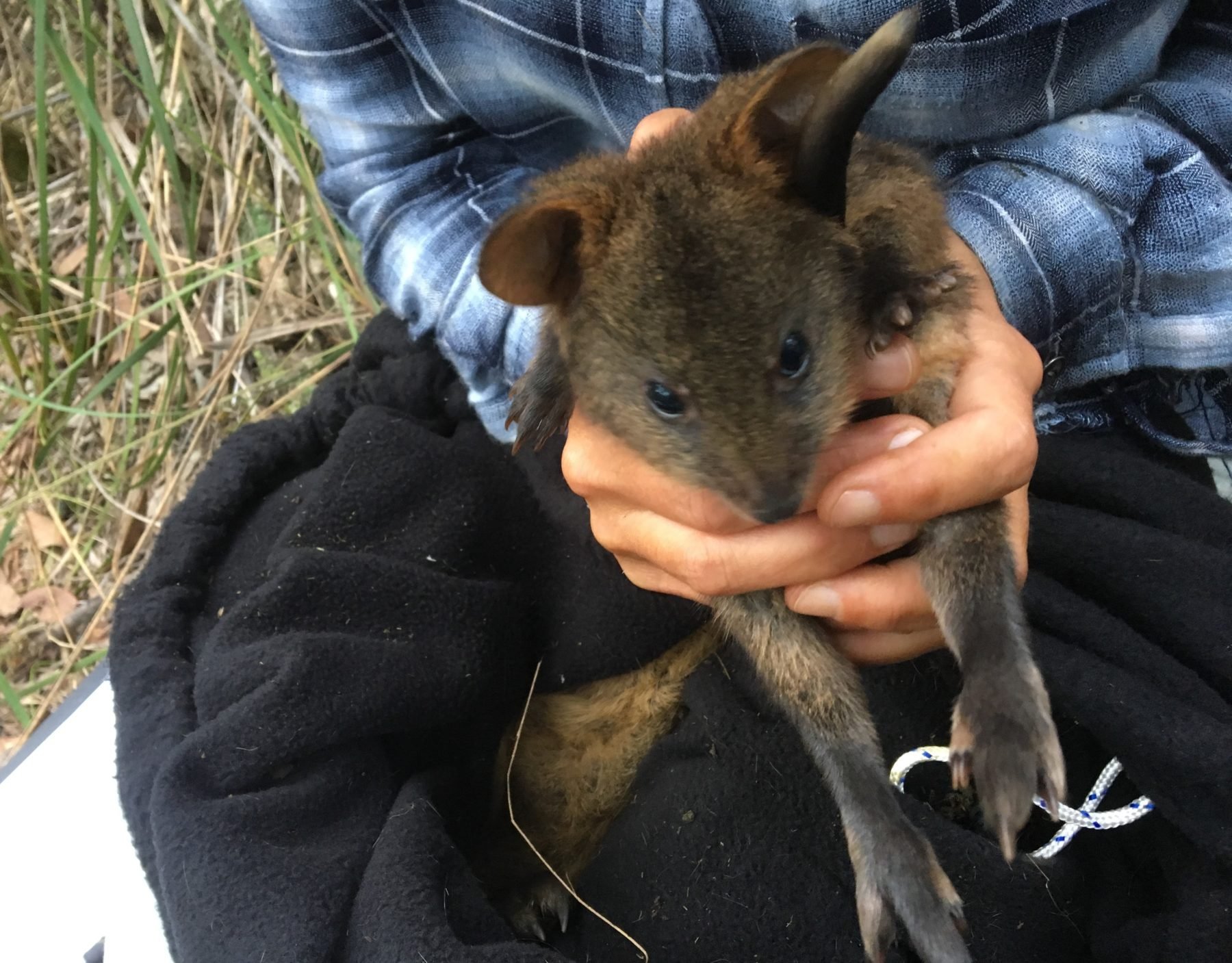
A main aim of this project has been to provide advice and mapping to land managers such as DBCA and the Forest Products Commission on the best ways to manage the landscape in terms of prescribed burns and other activities to protect quokkas in the Northcliffe area.
“It’s all about building resilience within the population by managing threatening processes, such as introduced predators and feral pigs, and proactively managing planned disturbances, such as fire and [timber] harvesting, to protect critical habitat and corridors for movement,” Karlene says.
Also affecting quokka recovery after the fire have been the feral predators foxes and cats. Karlene says DBCA is actively managing fox numbers. But because fox numbers have been so successfully reduced in the landscape, cats have taken over as the main predation risk for quokkas. With the habitat and crucial places to hide being limited post-fire, quokkas are more vulnerable than ever to feral cats.
There is no obvious way to control these introduced predators. Karlene says she has recently been involved in studies to test a poison bait to help reduce the impact of feral cats, but unless the cats’ prey resources are already limited, baits are ineffective. “We just finished trials in the Southern Forest in the last couple of months,” Karlene says. “The results are basically indicating that the cats have no interest whatsoever in the bait.”
Another threat is feral pigs, which have a disturbing effect on fire-ravaged ground, especially in the first three years after a fire. The wallowing and digging of pigs can disturb soil structure, new seedlings and the underground lignotubers of native trees that are a natural response mechanism to fire. These factors modify the understorey and vegetation structure. “For quokkas, these elements are important for their physiology and to provide protection from predators,” Karlene says. Where the pigs are managed effectively during the first three years after fire, they are less of a threat. If unmanaged, they return to the same areas and the damage they cause continues to contribute to unsuitable habitat for quokkas.
While the Northcliffe quokka study has concluded for now, Karlene hopes to one day revisit the project, funding permitting. “At this point, the 42 per cent recovery at year five and the large distances between areas that are unoccupied indicate that the metapopulation is not quite functional yet,” she says. “So to be able to go back in and assess the level of recovery, not just in terms of numbers but in terms of the area that’s currently occupied and how it’s all linking together, is critical to inform how this affects the broader metapopulation structure.”
Climate change another challenge
Other significant challenges lie ahead for quokkas and, as for many species, the spectre of climate change looms large. “The predictions are that the South West is going to experience the most drying conditions of anywhere in Australia,” Rochelle says. “The species that live within that forest may or may not be able to keep up with that change depending on how well we look after their habitats now. If the forest is drying, it will dry out a lot faster if we cut more of it down.”
Karlene agrees, explaining that quokkas, like many other species, rely on the moister parts of the landscape, such as the riparian vegetation beside watercourses. Karlene hypothesises that the Southern Forests habitats of quokkas will become even more important as habitats dry out further north. “Hope-
fully they’ll remain moist for longer,” she says.
Looking forward, both scientists would like to see greater protection for the Southern Forests, and Rochelle has a suggestion. “Explore some of the climate correcting strategies around carbon credits and carbon farming,” she says.
Rochelle would like land managers to think innovatively about how to look after the forest and still maintain livelihoods for people throughout the South West.
“We are going to need alternative ways for our economy to survive in lieu of other industries that are maladaptive when it comes to climate change and species conservation,” she says.
For WWF-Australia, conserving quokkas serves an even greater purpose. By researching and protecting this much-loved species and trying to ensure they can persist into the future, other lesser-known animals and ecosystem components may also survive. “If you’re looking after the quokkas, then what you’re doing is also benefiting a whole range of other species,” Karlene says.
In good news for the quokkas of the Southern Forests, in September this year, the WA government announced that native forest logging will end at the start of 2024, making WA the first state to institute such a ban. The state government will spend $350 million to expand softwood timber plantations and $50 million to support affected communities.
These days, Roger’s Instagram account is focused back on tennis, and Kylie is posting flashbacks about her first hit song, “Locomotion”. Celebrity quokka selfies may have run their course. They were never meant to be a conservation tool. But perhaps, on some level, the fame they brought these Rottnest Island mascots can help raise awareness, and funds, for conservation of their mainland cousins.
Quokka populations have reduced drastically over the past 100 years due to threats such as introduced predators like foxes and cats, habitat destruction and disease. It is now listed as vulnerable on the IUCN Red List. Rottnest Island off the coast of Western Australia is home to Australia’s largest population with more than 10,000 individuals, although threats, such as climate change and disease still pose a risk to the animals.
With support from the Rottnest Foundation, The Rottnest Island Environment team monitor the Island’s quokka population to help detect changes, which may signal the need for management actions. However, the size of the island makes it challenging to monitor large parts of the quokkas’ habitat.
Your support will help purchase remote cameras, which will enable the continuous 24/7 monitoring of large areas of the Island, helping to ensure quokkas are protected and visitors to the island can still enjoy these magic encounters.
